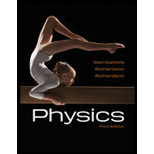
(a)
The possible values of charges.
(a)
Answer to Problem 86P
The charge of Sun can be 1.712×1020 C and the charge of Earth can be 5.148×1014 C.
Explanation of Solution
Write an expression for equilibrium condition for gravitational and electrical force.
k|qS||qE|r2=GmSmEr2 (I)
Here, k is the Coulomb’s constant, qS is the charge of Sun, qE is the charge of Earth, r is the distance between Earth and Sun, G is the gravitational constant, mS is the mass of Sun and mE is the mass of Earth.
Rewrite equation (I).
|qS||qE|=GkmSmE (II)
Consider,
|qS|mS=|qE|mE (III)
Rewrite equation (III) to find |qE|.
|qE|=mEmS|qS| (IV)
Rewrite equation (II) to find |qS|.
|qS|=GkmSmE(1|qE|) (V)
Substitute equation (IV) in equation (V).
|qS|=GkmSmE(1mEmS|qS|)=GkmSmE(mSmE|qS|) (VI)
Rewrite equation (VI) to find |qS|.
|qS|=√GkmS (VII)
Rewrite equation (III) to find |qS|.
|qS|=mSmE|qE| (VIII)
Rewrite equation (II) to find |qE|.
|qE|=GkmSmE(1|qS|) (IX)
Substitute equation (VIII) in equation (IX).
|qE|=GkmSmE(1mSmE|qE|)=GkmSmE(mEmS|qE|) (X)
Rewrite equation (X) to find |qE|.
qE=√GkmE (XI)
Conclusion:
Substitute 1.987×1030 kg for mS, 6.674×10−11 N⋅m2/kg2 for G and 8.988×109 N⋅m2/C2 for k in equation (VII) to find |qS|.
|qS|=(√6.674×10−11 N⋅m2/kg28.988×109 N⋅m2/C2)(1.987×1030 kg)=√(0.74×10−20 C2/kg2)(1.987×1030 kg)=1.712×1020 C
Substitute 5.974×1024 kg for mE, 6.674×10−11 N⋅m2/kg2 for G and 8.988×109 N⋅m2/C2 for k in equation (XI) to find |qE|.
|qE|=(√6.674×10−11 N⋅m2/kg28.988×109 N⋅m2/C2)(5.974×1024 kg)=√(0.74×10−20 C2/kg2)(5.974×1024 kg)=5.148×1014 C
Thus, the charge of Sun can be 1.712×1020 C and the charge of Earth can be 5.148×1014 C. Let the charge of Sun is positive and charge of Earth is negative.
(b)
If charge imbalance explain Earth’s orbit.
(b)
Answer to Problem 86P
No, the charge imbalance explain Earth’s orbit.
Explanation of Solution
Consider the charge of electron and proton is different. The net charges on astronomical bodies are the sum of charge of the particles. If the magnitude of the charges of the proton and electron were not exactly equal, astronomical bodies will have a total charge with the same sign.
Like charges will repel each other. Since the charges of the astronomical bodies are similar, the force between them would be repulsive. The force responsible for the Earth’s orbit is attractive. Thus, the charge imbalance explain Earth’s orbit.
Want to see more full solutions like this?
Chapter 16 Solutions
Physics
- Hi! I need help with these calculations for part i and part k for a physics Diffraction Lab. We used a slit width 0.4 mm to measure our pattern.arrow_forwardExamine the data and % error values in Data Table 3 where the angular displacement of the simple pendulum decreased but the mass of the pendulum bob and the length of the pendulum remained constant. Describe whether or not your data shows that the period of the pendulum depends on the angular displacement of the pendulum bob, to within a reasonable percent error.arrow_forwardIn addition to the anyalysis of the graph, show mathematically that the slope of that line is 2π/√g . Using the slope of your line calculate the value of g and compare it to 9.8.arrow_forward
- An object is placed 24.1 cm to the left of a diverging lens (f = -6.51 cm). A concave mirror (f= 14.8 cm) is placed 30.2 cm to the right of the lens to form an image of the first image formed by the lens. Find the final image distance, measured relative to the mirror. (b) Is the final image real or virtual? (c) Is the final image upright or inverted with respect to the original object?arrow_forwardConcept Simulation 26.4 provides the option of exploring the ray diagram that applies to this problem. The distance between an object and its image formed by a diverging lens is 5.90 cm. The focal length of the lens is -2.60 cm. Find (a) the image distance and (b) the object distance.arrow_forwardPls help ASAParrow_forward
 College PhysicsPhysicsISBN:9781305952300Author:Raymond A. Serway, Chris VuillePublisher:Cengage Learning
College PhysicsPhysicsISBN:9781305952300Author:Raymond A. Serway, Chris VuillePublisher:Cengage Learning University Physics (14th Edition)PhysicsISBN:9780133969290Author:Hugh D. Young, Roger A. FreedmanPublisher:PEARSON
University Physics (14th Edition)PhysicsISBN:9780133969290Author:Hugh D. Young, Roger A. FreedmanPublisher:PEARSON Introduction To Quantum MechanicsPhysicsISBN:9781107189638Author:Griffiths, David J., Schroeter, Darrell F.Publisher:Cambridge University Press
Introduction To Quantum MechanicsPhysicsISBN:9781107189638Author:Griffiths, David J., Schroeter, Darrell F.Publisher:Cambridge University Press Physics for Scientists and EngineersPhysicsISBN:9781337553278Author:Raymond A. Serway, John W. JewettPublisher:Cengage Learning
Physics for Scientists and EngineersPhysicsISBN:9781337553278Author:Raymond A. Serway, John W. JewettPublisher:Cengage Learning Lecture- Tutorials for Introductory AstronomyPhysicsISBN:9780321820464Author:Edward E. Prather, Tim P. Slater, Jeff P. Adams, Gina BrissendenPublisher:Addison-Wesley
Lecture- Tutorials for Introductory AstronomyPhysicsISBN:9780321820464Author:Edward E. Prather, Tim P. Slater, Jeff P. Adams, Gina BrissendenPublisher:Addison-Wesley College Physics: A Strategic Approach (4th Editio...PhysicsISBN:9780134609034Author:Randall D. Knight (Professor Emeritus), Brian Jones, Stuart FieldPublisher:PEARSON
College Physics: A Strategic Approach (4th Editio...PhysicsISBN:9780134609034Author:Randall D. Knight (Professor Emeritus), Brian Jones, Stuart FieldPublisher:PEARSON





